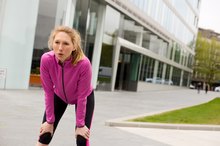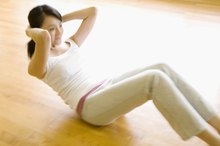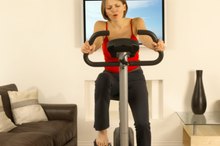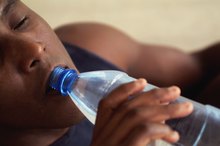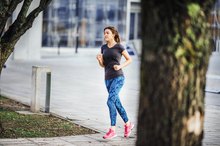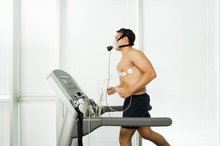How Does Exercise Affect Breathing?
When you are exercising aerobically, your muscles consume more oxygen and produce more carbon dioxide than they do at rest. These gases are exchanged with the atmosphere when you breathe. This means that during an aerobic exercise session, you must breathe more and when this overload is encountered on a regular basis, the way you breathe is altered.
Minute Ventilation
Minute ventilation is the volume of air you breathe in a minute. Minute ventilation is measured in liters and can be calculated by multiplying tidal volume by breathing rate. Tidal volume is the volume of air that you inhale with each breath and breathing rate is the number of breaths you take each minute. During normal quiet breathing at rest, the typical minute ventilation of 6 liters is achieved by a tidal volume of 0.5 liters and a breathing rate of 12 breaths per minute.
- Minute ventilation is the volume of air you breathe in a minute.
During Exercise
Calories Burned at Rest
Learn More
Minute ventilation increases during exercise because both tidal volume and breathing rate increase. At relatively low exercise intensities, tidal volume and breathing rate increase proportionally. However, at higher relative intensities, tidal volume reaches a plateau and further increases in minute ventilation depend exclusively upon increasing breathing rate. During strenuous exercise, healthy young adults typically breathe 35 to 45 times each minute and some elite endurance athletes breathe as many as 60 to 70 times. Minute ventilation values of 200 liters have been observed in athletes during maximal bicycle exercise.
- Minute ventilation increases during exercise because both tidal volume and breathing rate increase.
- However, at higher relative intensities, tidal volume reaches a plateau and further increases in minute ventilation depend exclusively upon increasing breathing rate.
Ventilatory Capacity
Oxygen is transported to your muscles and carbon dioxide is transported away from your muscles by your blood. The actual exchange of these gases with the air you breathe occurs in your lungs. Blood is circulated through your lungs by your cardiovascular system. Generally speaking, in most people, the capacity of your lungs far exceeds the capacity of your cardiovascular system. For example, as explained by Illinois State University’s Dale Brown in “Exercise and Sport Science,” a four- to five-fold increase in breathing rate and a five- to seven-fold increase in tidal volume during exercise compared to rest provide the potential to elevate minute ventilation to 20 to 30 times the resting value. This far exceeds the increase in the amount of blood you can circulate through your lungs during exercise, which is typically only five to seven times the resting value. This means that your cardiovascular system is the limiting factor and there will be no overload on your lungs that forces them to increase their capacity over time due to regular aerobic exercise.
- Oxygen is transported to your muscles and carbon dioxide is transported away from your muscles by your blood.
- This far exceeds the increase in the amount of blood you can circulate through your lungs during exercise, which is typically only five to seven times the resting value.
Ventilatory Efficiency
How Does Running Increase Lung Capacity?
Learn More
Regular aerobic exercise might not alter the maximum amount of air you can breathe, but it does improve the way you move the air that you do require. At any submaximal work rate, you will ventilate less and also establish a given minute ventilation with a greater tidal volume and reduced breathing rate. This is important because it makes breathing easier and reduces fatigue in your ventilatory muscles.
Related Articles
References
- “Exercise Physiology: Nutrition, Energy, and Human Performance Seventh Edition”; W.D. McArdle, F.I. Katch and V.L. Katch; 2010
- “Exercise Physiology: Human Bioenergetics and Its Application”; G.A. Brooks, T.D. Fahey and K.M. Baldwin; 2005
- “Exercise and Sport Science;” W.E. Garrett and D.T. Kirkendall; 2000
Writer Bio
Fred DiMenna has been writing professionally since 2000. He has authored research articles published in "Journal of Applied Physiology" and "Respiratory Physiology and Neurobiology," and has also been fitness editor for Chelo Publishing in Manhattan, which publishes fitness magazines including "Exercise for Men Only" and "Natural Bodybuilding and Fitness." DiMenna has a Ph.D. in exercise physiology from the University of Exeter.

